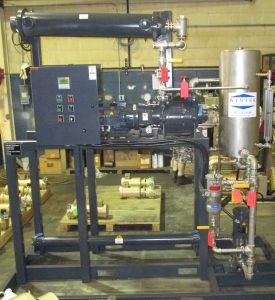Vacuum deaeration removes dissolved gasses from a liquid stream. Because boiler streams contain dissolved oxygen and carbon dioxide, the boiler industry uses vacuum deaeration frequently.
The Boiler Industry and Vacuum Deaerators
In the boiler process, oxygen and carbon dioxide become dissolved in liquid streams. This is an issue because oxygen causes corrosion and carbon dioxide is acidic. Thus, the pH level of the boiler stream can be low. These compounds produce acid that corrodes the boiler system. Vacuum deaerators remove dissolved gasses from boiler feeds. Removing these gasses via vacuum is more economical than removing them through chemicals. The systems reduce corrosion in boiler tubes caused by dissolved oxygen and carbon dioxide.
Deaeration is based on several principals. However, Henry’s Law is the driving principle. Henry’s Law states that the gas solubility is directly proportional to the partial pressure of the gas. Therefore, as the pressure lowers, so does the solubility of the gas. This is true for mixtures of gas and liquid in solution.
In a deaerator, feed water sprays into the stream. The inlet spray increases the surface area of transfer; thus, providing more efficient oxygen removal and lower gas concentrations. The removed gasses vent from the deaerator.
Vacuum Dearator System Design
Vacuum deaeration systems consist of three main components. Firstly, a vacuum deaerator which contains the liquid with dissolved gasses. Secondly, a vacuum pump which will be used to pull and maintain vacuum. Finally, a boiler feed water pump unit to push the liberated liquid through the system. A liquid ring vacuum pump is attached to the deaerator for removing the dissolved gasses. The liquid ring pump maintains a vacuum in the deaerator system. As stated, these low pressure conditions enhance the removal of dissolved gasses from the boiler feed water. Wintek has designed and built vacuum dearation systems for a variety of boiler companies.

